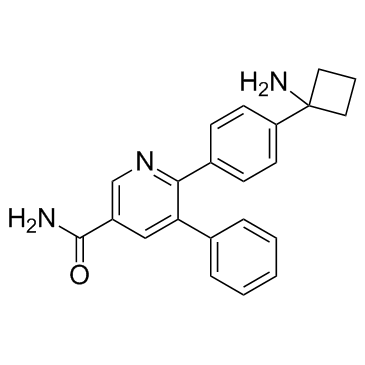1357158-81-6
| Name | 6-(4-(1-aminocyclobutyl)phenyl)-5-phenylnicotinamide |
|---|---|
| Synonyms |
6-[4-(1-Aminocyclobutyl)phenyl]-5-phenylnicotinamide
3-Pyridinecarboxamide, 6-[4-(1-aminocyclobutyl)phenyl]-5-phenyl- 6-[4-(1-Aminocyclobutyl)phenyl]-5-phenyl-3-pyridinecarboxamide AZD-26 AKT-IN-1 |
| Description | AKT-IN-1 is an allosteric AKT inhibitor with an IC50 of 1.042 μM. |
|---|---|
| Related Catalog | |
| Target |
IC50: 1.042 μM (AKT)[1] |
| In Vitro | AKT-IN-1 (Compound 26) is able to potently inhibit phosphorylation of AKT in cells at both Thr308 and Ser473, with IC50s of 0.422 and 0.322 μM, respectively. AKT-IN-1 inhibits the phosphorylation of ribosomal protein S6, a downstream effector of the PI3K-AKT pathway. AKT-IN-1 potently inhibits the phosphorylation of PRAS40[1]. |
| In Vivo | The effects of AKT-IN-1 (Compound 26) in vivo are characterized by measuring the pharmacodynamic activity of AKT-IN-1 in a BT474c breast adenocarcinoma xenograft model. Following acute doses of 100 and 200 mg/kg, AKT-IN-1 potently inhibits the phosphorylation of its downstream substrate GSK3β as well as the phosphorylation of AKT (Ser473), with a potency consistent with its pharmacokinetic profile. The in vivo activity of AKT-IN-1 is further characterized by measuring the effects on the growth of tumor cell xenografts. Continuous (daily) oral dosing of AKT-IN-1 (100 and 200 mg/kg) to nude mice bearing BT474c breast adenocarcinoma xenografts results in inhibition of tumor growth in a dose-dependent manner. When dosed at 200 mg/kg daily, AKT-IN-1 causes significant tumor growth inhibition[1]. |
| References |
| Density | 1.2±0.1 g/cm3 |
|---|---|
| Boiling Point | 496.4±45.0 °C at 760 mmHg |
| Molecular Formula | C22H21N3O |
| Molecular Weight | 343.422 |
| Flash Point | 254.0±28.7 °C |
| Exact Mass | 343.168457 |
| PSA | 82.00000 |
| LogP | 2.87 |
| Vapour Pressure | 0.0±1.3 mmHg at 25°C |
| Index of Refraction | 1.643 |
| Storage condition | 2-8℃ |
| Water Solubility | Practically insoluble (0.041 g/L) (25 ºC) |
